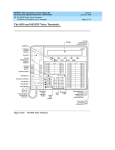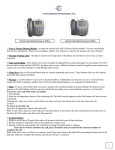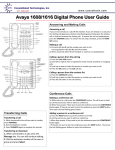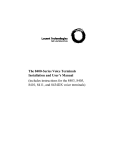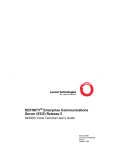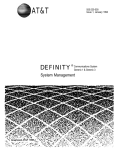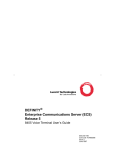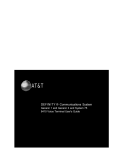Download Definity 8410D User`s guide
Transcript
Issue 9 January 1998 DEFINITY ECS and System 75 and System 85 Terminals and Adjuncts Reference 555-015-201 12 The 8400 Series Voice Terminals The 8410 Voice Terminal Page 12-34 The 8410 Voice Terminal 8410D Display Handset 4 Softkeys Menu Exit Prev Next 4 Display Control Buttons Volume Control Button 10 Call Appearance/ Feature Buttons Transfer Button Handset Jack (on left side of terminal) Message Light Message Volume ABC Shift Button Shift Test Button Test Conf Mute Drop Speaker Hold Mute Button Transfer Reset Spkr Speaker/ Reset Speaker Button Ring Hold/Ring Button 1 DEF 2 GHI JKL 4 5 PQRS TUV 3 MNO 6 LINE WXYZ 7 8 9 * O # Dial Pad Conference Button Drop Button Figure 12-11. One Version of the 8410D Voice Terminal (with Display) Line Jack (on back of terminal) Speakerphone/ Headset Adapter Jack (on back of terminal) Issue 9 January 1998 DEFINITY ECS and System 75 and System 85 Terminals and Adjuncts Reference 555-015-201 12 The 8400 Series Voice Terminals The 8410 Voice Terminal Page 12-35 Display Handset Softkeys Menu Exit Prev Next Volume control button Display control buttons 10 Call appearance/ feature buttons Transfer button Message light Volume ABC Ring Ring button Test button Mute button Speaker button Transfer Test Conf Mute Drop Speaker Hold 1 DEF 2 GHI JKL 4 5 PQRS TUV 3 MNO 6 LINE Line jack (on back of voice terminal) WXYZ 7 8 9 * O # Speakerphone/ headset adapter jack (on back of voice terminal) Dial pad Conference button Handset jack Figure 12-12. Drop button Hold button Another Version of the 8410D Voice Terminal The 8410 voice terminal is a multi-appearance digital telephone with 10 call appearance/feature buttons, four standard fixed feature buttons (CONFERENCE, DROP, HOLD, and TRANSFER), a MUTE button, a SPEAKER button which can access either a 2-way speakerphone or a 1-way, listen-only speaker, a TEST button, and a Volume control button. In addition, some 8410 voice terminals have a blue SHIFT button; other 8410 voice terminals have a RING button instead. There are two varieties of the 8410 voice terminal: the 8410B (8410D04A) is the basic set, without a display; the 8410D (8410D03A) has a built-in 2-line by 24-character display. NOTE: The 8410D01A and 8410D02A are older versions of this voice terminal and are no longer available. Those users who have an 8410D with display can access 12 features with the softkeys and display control buttons. These 12 features can be used in addition to the features on the call appearance/feature buttons. DEFINITY ECS and System 75 and System 85 Terminals and Adjuncts Reference 555-015-201 Issue 9 January 1998 12 The 8400 Series Voice Terminals The 8410 Voice Terminal Page 12-36 The 8410 voice terminal can work in both 4-wire and 2-wire environments. For more information, see ‘‘Wiring Information.” Applications The 8410 voice terminal can be used with the DEFINITY Communications System Generic 1, Generic 2, or Generic 3, the DEFINITY ECS, System 75, and System 85. This type of voice terminal is especially suitable for managers, executive secretaries, and other office support personnel who require access to multiple lines for call handling, call coverage, bridging, conferencing, and sophisticated voice communications. The display set can be used by those who have a need for calling party display capabilities or who require a large number of voice terminal features. The 8410 voice terminals can also provide the user with simultaneous voice and data communications. The 8410 can be connected to a 7400B Plus Data Module. With the 8410 voice terminal, PC platform products can be useful in providing voice capabilities since these screen-based products can greatly enhance the telephone capabilities of these voice terminals. Physical Features Dimensions NOTE: The dimensions described here for the 8410 voice terminal are approximate. Width = 7.8 inches Depth (front to back) = 9.5 inches Height (maximum with handset in place) = low position, 5.265 inches high position, 6.625 inches Features Eight Fixed Feature Buttons The 8410 has the following eight fixed feature buttons: ■ CONFERENCE (labeled CONF) button ■ DROP button ■ TRANSFER button ■ A red HOLD button ■ Either a blue SHIFT button or a RING button DEFINITY ECS and System 75 and System 85 Terminals and Adjuncts Reference 555-015-201 Issue 9 January 1998 12 The 8400 Series Voice Terminals The 8410 Voice Terminal ■ MUTE button ■ SPEAKER button ■ TEST button Page 12-37 The SHIFT Button Some 8410 voice terminals have a blue SHIFT button that can be used in the following ways: (The red light next to the SHIFT button goes on steadily when the button is activated.) ■ Used with the HOLD button to select your own personalized ring from among eight available patterns ■ Used with the SPEAKER button to perform an acoustic test of the environment and adjust the speakerphone to the surrounding acoustic environment for optimal performance The RING Button On other 8405 voice terminals, the user can press the RING button in order to select a personalized ringing pattern for the voice terminal. There are eight ringing patterns from which to choose. Call Appearance/Feature Buttons The 8410 voice terminal has 10 call appearance/feature buttons, each equipped with a red and a green status light. Usually, at least three of these buttons are administered as call appearances for the terminal’s primary extension number, where calls are placed and answered. The rest of the buttons can be used for more call appearances (including bridged appearances of other stations’ extensions) and features. Buttons administered for features have only their status lights active. Message Light The red Message light goes on when a message is left for the user. It goes off when the user retrieves the message or when the message is erased. This light is . labeled either Message or Speakerphone The 8410 voice terminal is equipped with a built-in speakerphone. (The voice terminal can be optioned for a 1-way, listen-only speaker instead.) The Speakerphone capability allows a user to engage in a hands-free conversation with the far-end party. The speakerphone can be turned on or off with the SPEAKER button; can be muted with the MUTE button, and the volume can be raised and lowered with the VOLUME ‘‘arrow” button. If the voice terminal has a SHIFT button and Rest Spkr appears below the SPEAKER button, the user can access the Reset Speakerphone feature to adjust the speakerphone for optimal performance. DEFINITY ECS and System 75 and System 85 Terminals and Adjuncts Reference 555-015-201 Issue 9 January 1998 12 The 8400 Series Voice Terminals The 8410 Voice Terminal Page 12-38 NOTE: If there is not a SHIFT button and Reset Spkr does NOT appear under the SPEAKER button, the voice terminal will adjust to the surrounding environment by itself. The user does not need to do anything manually. By pressing the blue SHIFT button on the set and then the SPEAKER button (if the voice terminal is set for the Speakerphone feature), the user hears a set of tones as the speakerphone performs an acoustic test of the environment. When the tones stop, the speakerphone has finished adjusting itself and is ready for use. The user must reset the speakerphone in any of three instances: whenever the voice terminal is moved to another place (even in the same room), whenever the red light next to the SPEAKER button is fluttering, and, when, in the unlikely event, the speakerphone is making a squealing sound. Speaker (Listen-Only) Feature Although the 8410 voice terminal is shipped from the factory with the terminal set for the Speakerphone feature, the 8410 voice terminal can be optioned instead for a 1-way, listen-only speaker. If this is the case, use the SPEAKER button on the front of the voice terminal for turning on and off the speaker. The Speaker (listen-only) capability allows a user to engage in a 1-way conversation with the far-end. Specifically, the user can only listen to the far-end. To speak with the far-end, the user must use the handset which turns off the speaker. The Speaker function may also be disabled. MUTE Button The MUTE button is a fixed feature button with a red status light. The MUTE button turns off the microphone of the built-in speakerphone or the handset so that a person can converse with another person in the room without the other party listening in. VOLUME Control Button The 8410 voice terminal has a VOLUME ‘‘arrow” button on the front of the set. This button has several functions. When the user is using the speakerphone or the 1-way speaker, the VOLUME button controls the volume of the speaker. When the user is on a call using the handset, the VOLUME button controls the handset volume. When the voice terminal is idle, the button controls the volume of the tone ringer. When the user sets the volume for the speaker, speakerphone, handset, or the tone ringer, the display on the 8410D voice terminal shows a ‘‘bar array” that indicates the volume setting. Issue 9 January 1998 DEFINITY ECS and System 75 and System 85 Terminals and Adjuncts Reference 555-015-201 12 The 8400 Series Voice Terminals The 8410 Voice Terminal Page 12-39 TEST Button When the voice terminal is initially powered up, the green light next to the TEST button flashes if the link with the PBX is not (or not yet) operational. The light changes to steady green when the voice terminal is able to communicate with the PBX. After the voice terminal is powered up, you can press the TEST button to test the lights and the display on your voice terminal. Display The display on the 8410D set has two lines with 24 characters on each line. The display, along with the softkeys and the display control buttons, can be used to access 12 softkey features (the default softkey features and the alternative softkey features are listed under ‘‘Softkeys”). Display Control Buttons These four buttons are labeled ■ ■ Menu Menu , Exit , Prev , and Next . is used to enter Softkey Mode and access the 12 softkey features. Exit is used for exiting a display feature and returning to Normal (call-handling) Mode. Prev and Next ■ can be used to go back and forth through the feature option screens. Softkeys The four buttons located below the display and labeled with arrows correspond to features listed on the second line of the display screen. (There are four features on each feature option screen.) The user can access any of the 12 features by pressing the softkey below the feature abbreviation. Issue 9 January 1998 DEFINITY ECS and System 75 and System 85 Terminals and Adjuncts Reference 555-015-201 12 The 8400 Series Voice Terminals The 8410 Voice Terminal Page 12-40 Below is a list of the 12 default softkey features assigned to the 8410 and the order in which they appear. Table 12-10. Default Softkey Features on the 8410 Abbreviation Feature First Screen LWC Leave Word Calling CnLWC Cancel Leave Word Calling AutCB Automatic Callback Timer Timer Second Screen CFrwd1 Call Forward CPark2 Call Park TmDay Time/Date PCall Priority Calling Third Screen Prog Abbreviated Dialing Program Pause Abbreviated Dialing Special Function Pause Mark Abbreviated Dialing Special Function Mark Wait Abbreviated Dialing Special Function Wait 1. 2. On a DEFINITY Generic 2 or on a System 85, this feature is named Call Forward-Follow Me. On a DEFINITY G2 and on a System 85, there is no Call Park feature that can be assigned to a feature button. In order to have the Call Park function on a softkey or hard button, administer the button as an Abbreviated Dial button and program the Call Park trunk group access code onto it. This button can then be labeled ‘‘Call Park.” In addition, on a DEFINITY G2 or a System 85, the Recall feature must be administered on a standard feature button. On 8410D voice terminals (8410 terminals with a display) connected to a DEFINITY G3V3 or later, the System Manager can choose to administer alternate features for use with the softkeys. The following table lists some of the alternate softkey features, those features that can be substituted for the default softkey features listed on the previous page. NOTE: The DEFINITY ECS Release 5 (and later releases) may provide additional alternate softkey features. NOTE: With G3V3 and later switches, the system can download BLANK softkey labels for positions where there are no features administered. DEFINITY ECS and System 75 and System 85 Terminals and Adjuncts Reference 555-015-201 Issue 9 January 1998 12 The 8400 Series Voice Terminals The 8410 Voice Terminal Table 12-11. Page 12-41 Alternate Softkey Features on the 8410 Connected to a DEFINITY G3V3 and Later Abbreviation Feature AD Abbreviated Dialing buttons (can be multiple AD buttons) Cnslt Consult Count ACD Stroke Count CPkup Call Pickup Dir1 Directory Excl Manual Exclusion HFAns2 Internal Auto Answer IAuto Intercom Auto IDial Intercom Dial Inspt Inspect Last Last Number Dialed RngOf Ringer Off SAC Send All Calls SFunc Abbreviated Dialed Special Function Spres Abbreviated Dialing Special Function Suppress Stats View (ACD) Statistics Stop Abbreviation Dialing Indefinite Wait or Stop View3 Stored Number 1. 2. 3. A CALL DISPLAY button should be administered, if access to System Directory is provided. It is also desirable for a NEXT DISPLAY button to be administered. This feature is not available on a DEFINITY G2 or System 85. This feature is not available on a DEFINITY G2 or System 85. This feature is available only on a DEFINITY G3V2 (or later) switches. DEFINITY ECS and System 75 and System 85 Terminals and Adjuncts Reference 555-015-201 Issue 9 January 1998 12 The 8400 Series Voice Terminals The 8410 Voice Terminal Page 12-42 Other Physical Features Handset The 8410 voice terminal is equipped with a K-type handset. Dial Pad The 8410 voice terminal is equipped with a 12-button touch-tone dial pad. The letters ‘‘Q” and ‘‘Z” have been added to the appropriate dial pad keys for directory access, and the ‘‘5” button on the dial pad has raised bars for visually-impaired users. Jacks The 8410 voice terminal’s housing has a Line jack located on the back of the housing, and a Handset cord jack located on the side of the set. There is also a Speakerphone/headset adapter jack to which the user can connect adjunct equipment. Cords Two cords are supplied with the 8410: a coiled 9-foot handset cord and a 7-foot line cord. Optional longer cords are available: a 12-foot handset cord and 14-foot and 25-foot line cords. Ringing The 8410 voice terminal has electronic tone ringing with eight possible ringing patterns that can be selected with the RING button on some 8405 voice terminals; on other voice terminals, the user presses the SHIFT button and the HOLD button in order to choose a ringing pattern. The loudness of the tone ringer can be controlled by the VOLUME ‘‘arrow” button. (The user must NOT be on a speakerphone call. If the user is using the speakerphone, the VOLUME ‘‘arrow” button controls the volume of the speakerphone.) Mounting Options The 8410 voice terminal comes equipped with a 2-position desk stand. This stand can also be removed so the user can mount the set on the wall. Color Options The 8410 voice terminal is available in black and in white. Issue 9 January 1998 DEFINITY ECS and System 75 and System 85 Terminals and Adjuncts Reference 555-015-201 12 The 8400 Series Voice Terminals The 8410 Voice Terminal Page 12-43 Wiring Information The 8410 voice terminal works in both 4-wire and 2-wire DCP configurations. The table below describes the pins on an 8400-Series voice terminal LINE jack. Table 12-12. The Pins on an 8400-Series Voice Terminal LINE Jack Line Interface Pin Pair Name Description 1 2 OD1 4-Wire Output 2 2 OD2 4-Wire Output 3 3 ID1 4-Wire Input 4 1 U-T 2-Wire (Tip) 5 1 U-R 2-Wire (Ring) 6 3 ID2 4-Wire Input 7 4 P1- Adjunct Power -48V 8 4 P2+ Adjunct Power Common NOTE: Regardless of which configuration is in use, ALL wiring between the PBX and the terminal MUST consist of twisted-pairs, including the modular line cord. The line cord must be a D8W, which consists of 4 twisted-pairs, or a Lucent Technologies-approved equivalent. Twisted-pair wiring is used to make lines less sensitive to crosstalk. Therefore, failure to use twisted pair wiring may result in less-than-optimum performance of the terminal and may also contribute to problems with the line. An 8-wire modular cord MUST be used for all 4-wire and any 2-wire installations requiring auxiliary power. NOTE: You do NOT need to change any settings on the voice terminal for 2-wire or 4-wire installations. The voice terminal is able to detect whether it is in a 2-wire or a 4-wire configuration. For 2-wire operation, if you need to plug the voice terminal into a 4-pin or 6-pin wall jack, instead of a standard 8-pin modular jack, refer to the ‘‘Line Interface” table to insure that the wires from the 4-pin or 6-pin wall jack are connected to the correct pins on the terminal ‘‘LINE” jack. Issue 9 January 1998 DEFINITY ECS and System 75 and System 85 Terminals and Adjuncts Reference 555-015-201 12 The 8400 Series Voice Terminals The 8410 Voice Terminal Page 12-44 In order for the terminal to function properly in either 2-wire or 4-wire installations, there must be NO INTERCONNECTIONS between the wire pairs used for 2-wire and 4-wire operations. Bridging or paralleling of these pairs can result in damage to the terminal or can cause the PBX circuit pack to remove power to the terminal. REMOVE ALL CONNECTIONS BETWEEN PAIRS BEFORE CONNECTING THE TERMINAL. 4-WIRE installations MUST ONLY have PBX connections on pair 2 and pair 3 and, if necessary, auxiliary power must be connected to pair 4. 2-WIRE installations MUST ONLY have PBX connections on pair 1 and, if necessary, auxiliary power must be connected to pair 4. Distance Limitations The following circuit packs can be used with all of the 8400-Series sets. Table 12-13. Circuit Packs Used with the 8400-Series Voice Terminals Circuit Pack 2/4-Wire Will support these switches TN2181 - 16-port 2-wire G3V2 and later TN754b - 8-port 4-wire All switches except System 85 TN754 - 8-port 4-wire All switches except System 85 TN413 - 8-port 4-wire International System 75 SN 270 and SN 270B - 4-port 4-wire System 85 R2V2 - R2V4 In 4-wire operation, the voice terminal must be within 5,000 feet of the PBX using 22-gauge or 24-gauge wire, and within 4,000 feet of the PBX using 26-gauge wire. In 2-wire operation, the voice terminal must be within 5,500 feet of the PBX using 22-gauge wire, within 3,500 feet of the PBX using 24-gauge wire, and within 2,200 feet of the PBX using 26-gauge wire. Power Requirements The 8410 voice terminal receives power from the system and does not require any external power supply. Additional external power IS required when the 8410 voice terminal is equipped with any adjuncts, such as an external speakerphone. Issue 9 January 1998 DEFINITY ECS and System 75 and System 85 Terminals and Adjuncts Reference 555-015-201 12 The 8400 Series Voice Terminals The 8410 Voice Terminal Page 12-45 In this instance, a 1151A1 local power supply or a 1151A2 power supply with Battery Holdover is recommended. Refer to the Adjunct Power section of this manual for more information on these power supplies. Switch Administration Aliasing Use the following table for administering the 8410B (the basic) voice terminal: Table 12-14. Administering the 8410B Voice Terminal If you have this System and this Release (which can support this type of operation) Administer the 8410B as a System 75 R1V1 — R1V3 4-wire only 7403D System 85 R2V2 — R2V4 4-wire only 7403D International System 75 IR1V4, etc. 4-wire only 7403D DEFINITY G1 4-wire only 7403D Global DEFINITY’91 4-wire only 7410D DEFINITY G2V1 4-wire only 7410D DEFINITY G2V2 4-wire only 7410D DEFINITY G3i, G3r, G3s, G3vs 4-wire only 7410D DEFINITY G3V2 2- or 4-wire 7410D DEFINITY G3V3 and later 2- or 4-wire 8410B Issue 9 January 1998 DEFINITY ECS and System 75 and System 85 Terminals and Adjuncts Reference 555-015-201 12 The 8400 Series Voice Terminals The 8410 Voice Terminal Page 12-46 Use the following table for administering the 8410D voice terminal (with display): Table 12-15. Administering the 8410D Voice Terminal If you have this System and this Release (which can support this type of operation) Administer the 8410D as a System 75 R1V1 — R1V3 4-wire only 7405D+D System 85 R2V2 — R2V4 4-wire only 7405D+D International System 75 IR1V4, etc. 4-wire only 7405D+D DEFINITY G1 R1V4 4-wire only 7405D+D Global DEFINITY’91 4-wire only 7405D+D DEFINITY G2V1 4-wire only 7405D+D DEFINITY G2V2 4-wire only 7405D+D DEFINITY G3i, G3r, G3s, G3vs 4-wire only 7405D+D DEFINITY G3V2 2- or 4-wire 7405D+D DEFINITY G3V3 and later 2- or 4-wire 8410D Button Numbering The following button diagrams of the 8410 voice terminal will help you administer both of these voice terminals connected to a System 75, a DEFINITY G1 and G3, or a DEFINITY ECS, and to a System 85 or a DEFINITY G2. Figure 13-13 shows button numbering for the 8410 connected to a System 75, a DEFINITY G1 and G3, or a DEFINITY ECS. Figure 13-14 shows button numbering for the 8410 connected to a System 85 or DEFINITY G2. If you need more information, refer to DEFINITY Communications System Generic 3 Implementation, 555-230-653, and DEFINITY Communications System Generic 2 Administration of Features and Hardware, 555-104-507. Issue 9 January 1998 DEFINITY ECS and System 75 and System 85 Terminals and Adjuncts Reference 555-015-201 12 The 8400 Series Voice Terminals The 8410 Voice Terminal Page 12-47 If the 8410D is administered as a 7405D, administer the 12 softkey features on “FEATURE BUTTON ASSIGNMENTS” 2 through 13; administer the Normal feature on Button #1. If the 8410D is administered as itself, administer the 12 softkey features on “SOFTKEY BUTTON ASSIGNMENTS” 1 through 12. 8410D Menu Exit Prev 1 6 2 7 3 8 4 9 5 10 The 10 call appearance/feature buttons are administered as “BUTTON ASSIGNMENTS” 1 through 10. Next Volume Figure 12-13. Ring Transfer Test Conf Mute Drop Speaker Hold ABC DEF 1 2 3 GHI JKL MNO PQRS TUV WXYZ 4 5 6 7 8 9 * O # Button Numbering for Administering the 8410 Voice Terminal Connected to a System 75, a DEFINITY G1 or G3, or a DEFINITY ECS Issue 9 January 1998 DEFINITY ECS and System 75 and System 85 Terminals and Adjuncts Reference 555-015-201 12 The 8400 Series Voice Terminals The 8410 Voice Terminal Page 12-48 If the 8410D is administered as a 7405D, administer the 12 softkey features on “FEATURE BUTTON ASSIGNMENTS” 14 through 25; administer the Normal feature on Button #13. If the 8410D is administered as itself, administer the 12 softkey features on “SOFTKEY BUTTON ASSIGNMENTS” 1 through 12. 8410D Menu Exit Prev 3 8 4 9 5 10 6 11 7 12 The 10 call appearance/feature buttons are administered as “BUTTON ASSIGNMENTS” 3 through 12. Next Volume Figure 12-14. Ring Transfer Test Conf Mute Drop Speaker Hold ABC DEF 1 2 3 GHI JKL MNO PQRS TUV WXYZ 4 5 6 7 8 9 * O # Button Numbering for Administering the 8410 Voice Terminal Connected to a System 85 or a DEFINITY G2 Power Failure Operation The 8410 voice terminal cannot be used as an emergency station during power failure transfer conditions. FCC Registration The 8410 voice terminal is FCC-registered along with the switch (as a system), but does not have a separate FCC registration label. DEFINITY ECS and System 75 and System 85 Terminals and Adjuncts Reference 555-015-201 Issue 9 January 1998 12 The 8400 Series Voice Terminals The 8410 Voice Terminal Page 12-49 UL and CSA Approval The 8410 voice terminal has been tested and has met the Underwriters Laboratories (UL) Standards UL 1459 and has also met the Canadian Standards Association (CSA) Standards CSA-C22.2 No.225-M90. Hearing Aid Compatible The 8410B and 8410D voice terminals are compatible with the inductively coupled hearing aids prescribed by the FCC. 8410 Equipment PECs and Comcodes The 8410B and 8410D voice terminals and components can be ordered with these PECs and Comcodes: ■ Basic 8410B (8410D04A) Voice Terminal Black 8410B Set PEC: 3234-04B Comcode: 107703696; White 8410B Set PEC 3234-04W Comcode: 107703738 ■ 8410D (8410D03A) Voice Terminal (with built-in display) Black 8410D Set PEC: 3235-05B Comcode: 107702870; White 8410D Set PEC: 3235-05W Comcode: 107702920 ■ K2S8 Handset Comcode: Black=107545584; White=107545568 ■ Handset cord (9 feet) Comcode: Black=407632819; White=407632835 ■ Line cord (7 feet) Comcode: 103786778 ■ Line cord (14 feet, silver) PEC: 2725-07N (COL18) Comcode: 103786828 ■ Line cord (25 feet, silver) PEC: 2725-07S (COL18) Comcode: 103786802 ■ Designation Card Cover PEC: 32309 Comcode: 846320216 ■ Button Designation Card Tractor Feed For 25 Sets, 3 Sheets (12 cards per sheet) PEC: 32310 Comcode: 847161817 DEFINITY ECS and System 75 and System 85 Terminals and Adjuncts Reference 555-015-201 Issue 9 January 1998 12 The 8400 Series Voice Terminals The 8410 Voice Terminal Page 12-50 Tractor Feed For 100 Sets, 9 Sheets (12 Cards per Sheet) PEC: 32311 Comcode: 847161916; Laser Printer Forms (8 1/2’’x11’’) 67 Sheets (6 Cards per Sheet) PEC: 32312 Comcode: 847065497 Adjuncts The following adjuncts can be used with the 8410 voice terminal: ■ S101A Speakerphone (no longer orderable) ■ S201A Speakerphone ■ CS201A Speakerphone ■ 7400B Plus Data Module ■ 500A Headset Adapter (and a standard headset; see ‘‘Headsets” below) ■ K6S2 Amplifier Handset ■ Shoulder Rest Headsets A list of compatible headsets, consisting of both modular and plug prong base units and selection of headpieces, appears in ‘‘Headset Adapters” in the Adjuncts section (behind the Adjuncts tab) later in this manual. Additional Documents The following documents contain additional information relating to the 8410 voice terminal: (Use the 9 digit number listed after each document to order that book from the BCS Publications Center for Lucent Technologies.) ■ 8403, 8410, and 8434 Voice Terminals Instructions for Installation, Switch Administration, and Programming the Options, 555-015-164 ■ DEFINITY Communications System Generic 1 and System 75 8410 Voice Terminal User’s Guide, 555-230-763 ■ DEFINITY Communications System Generic 1 and 3 and System 75 8410 Quick Reference Guide, 555-230-764 ■ DEFINITY Communications System Generic 2 and System 85 8410 Voice Terminal User’s Guide, 555-104-763 ■ DEFINITY Communications System Generic 2 and System 85 8410 Quick Reference Guide, 555-104-764

















